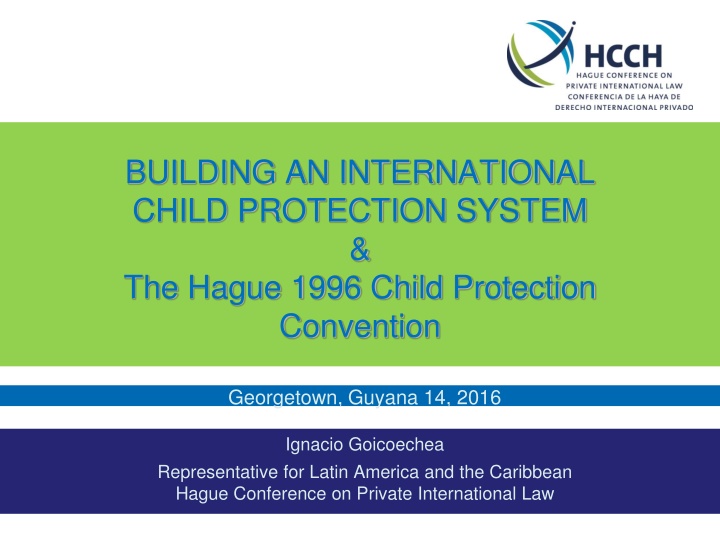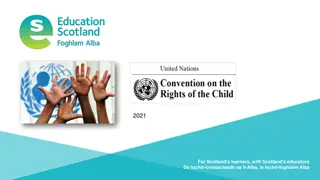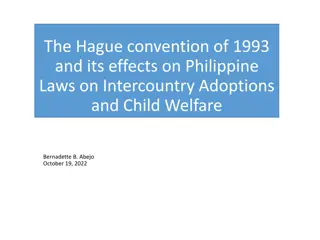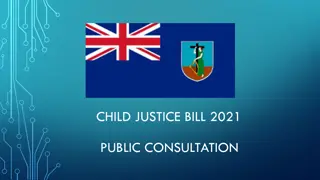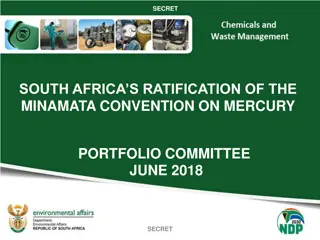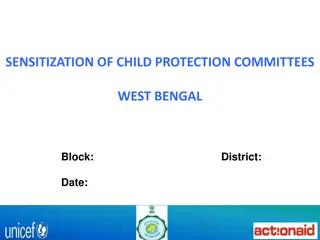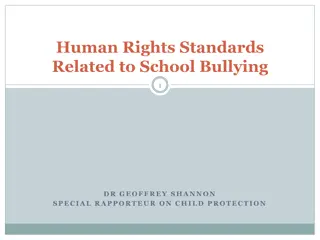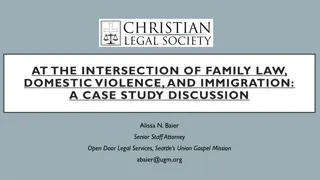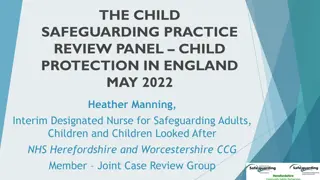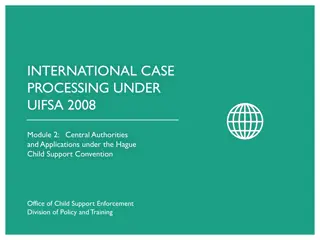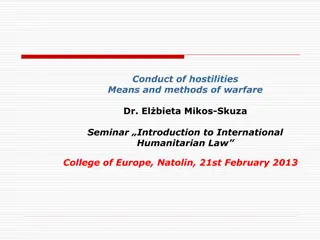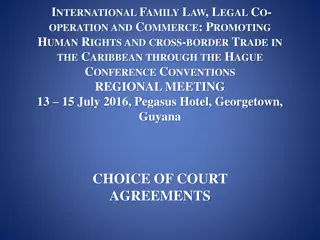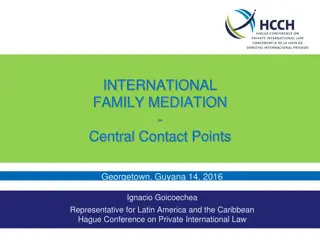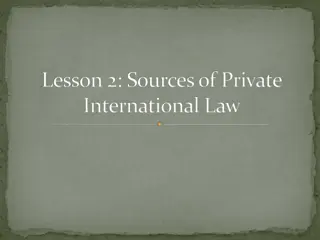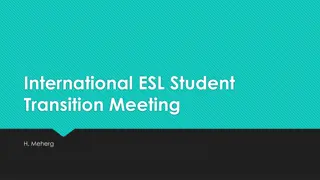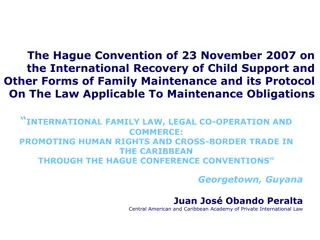Building an International Child Protection System: The Hague 1996 Convention
The need for an international child protection system stems from the globalization and increasing situations where children require coordinated actions across national borders. Limitations in national systems prompt the call for international cooperation through tools like conventions and networks. Emphasizing human rights, various conventions aim to protect children in cases of family conflicts, trafficking, abduction, and adoption.
Download Presentation

Please find below an Image/Link to download the presentation.
The content on the website is provided AS IS for your information and personal use only. It may not be sold, licensed, or shared on other websites without obtaining consent from the author.If you encounter any issues during the download, it is possible that the publisher has removed the file from their server.
You are allowed to download the files provided on this website for personal or commercial use, subject to the condition that they are used lawfully. All files are the property of their respective owners.
The content on the website is provided AS IS for your information and personal use only. It may not be sold, licensed, or shared on other websites without obtaining consent from the author.
E N D
Presentation Transcript
BUILDING AN INTERNATIONAL CHILD PROTECTION SYSTEM & The Hague 1996 Child Protection Convention Georgetown, Guyana 14, 2016 Ignacio Goicoechea Representative for Latin America and the Caribbean Hague Conference on Private International Law
WHY BUILD AN INTERNATIONAL CHILD PROTECTION SYSTEM?
General background Globalization Constant increase of situations where the effective protection of children requires coordinated actions of more than one National Child Protection System Examples: i) cross border family conflicts (custody, access, relocation, abduction, filiation, child support); ii) Victims of trafficking and abuse (abandonment, domestic violence, sexual exploitation, sale, etc.) iii) non accompanied children (children institutionalized abroad; children that are being deported) iv) international placements and intercountry adoptions.
Limitations of national child protection systems jurisdiction to intervene access to justice for the parties (legal representation, interpretation, etc.) access to foreign law service of process and taking of evidence abroad recognition and enforcement of protective measures locate family, provide social services, etc.
Remedy: develop international cooperation Objective articulate cooperation among the different national child protection systems. Tools International conventions, to provide the legal basis for such cooperation (global, regional and bilateral, levels available). International networks provide the means to make it efficient. Judges Networks Central Authorities & Contact points
Giving effect to Human Rights 1989 UN Convention on the Rights of the Child Articles 9(3) and 10(2) UNCRC Children whose parents do not live together have the right to stay in contact with both parents, except where contrary to the child s best interests Child Abduction & Child Protection Conventions Article 11 UNCRC States Parties shall take measures to combat the illicit transfer and non-return of children abroad (promotes conclusion of bilateral or multilateral agreements or accession to existing agreements) Child Abduction Convention Article 21 UNCRC For adoption, the best interests of the child shall be the paramount consideration (promotes conclusion of bilateral or multilateral agreements, which ensure that the placement of the child in another country is carried out by competent authorities) Adoption Convention Article 27(4) UNCRC States Parties shall take all appropriate measures to secure the recovery of maintenance for the child (promotes accession to international instruments or the conclusion of such agreements) Child Support Convention Article 35 UNCRC States Parties shall prevent abduction of, sale of, or traffic in children (requiring all appropriate national, bilateral and multilateral measures to be taken) Child Abduction, Adoption & Protection Conventions
The Hague Children Conventions 25 October 1980 Convention on the Civil Aspects of International Child Abduction Convention) 95 Contracting States (Child Abduction 29 May 1993 Convention on Protection of Children and Co- operation in respect of (Intercountry Adoption Convention) 96 Contracting States Intercountry Adoption 19 October 1996 Convention on Jurisdiction, Applicable Law, Recognition, Enforcement and Co-operation in respect of Parental Responsibility and Measures for the Protection of Children (Child Protection Contracting States Convention) 44 23 Recovery of Child Support and Other Forms of Family Maintenance (Child Support Contracting States November 2007 Convention on the International Convention) 33
Challenges: the long path for the convention to protect a child Development of an International Convention The State decides to incorporate the Convention State adjusts its legal system to implement the Convention State becomes party to the Convention Prospective users are informed about the existence and benefits of the Convention Operators of the Convention are trained in its use The Convention benefits children
THE HAGUE 1996 INTERNATIONAL CHILD PROTECTION CONVENTION
1996 Child Protection Convention Objectives (Preamble, Art. 1): Provide for the better protection of children in cross-border situations Avoid conflicts between legal systems in decisions concerning child protection all PIL aspects covered: jurisdiction, applicable law, recognition and enforcement, cooperation Does not seek to regulate national laws and procedures on parental responsibility or placement of children Confirms that the best interests of the child is paramount when it comes to child protection
Situations covered by the 1996 convention 1) Cross border family disputes (custody, access, relocation, parental responsibility). 2) International Child Abduction. 3) Unaccompanied children. 4) Victims of trafficking and abuse. 5) International placements.
Unaccompanied children & victims of trafficking and abuse Benefits provided by the 1996 Convention CAs shall provide assistance in discovering the whereabouts of a child (Art. 31(c)). CAs shall provide report on the situation of the child (Art. 32). Authorities in Contracting States where the child is present can take urgent measures of protection with effect in any State (Art. 11). The competent authorities of a Contracting State may request the authorities of another Contracting State to assist in the implementation of measures of protection taken under this Convention (art. 35) Measures of protection taken by the authorities of a Contracting State shall be recognised by operation of law in all other Contracting States (Art. 23).
The hague 1996 convention has been recommended: As a way of implementing the CDN Convention (Children Rights Committee General Observation N 5 General implementation measures(CRC/GC/2003/5). October 3, 2003 (In the Annex to this observation, the Committee encourages the ratification of the 1996 Convention) For the protection of unaccompanied minors (International Social Service Fact Sheet - Special Series on Unaccompanied Minors) For the placement of children abroad in foster care or institutional care ( United Nations Guidelines for the alternative care of children -par. 138-) As a complement to the 1980 Child Abduction and 1993 Intercountry Adoption Conventions (Special Commissions meetings that review the operation of these Conventions)
MANY THANKS ! Ignacio Goicoechea Representative for Latin America and the Caribbean Hague Conference on Private International Law E-mail: ig@hcch.nl http://www.hcch.net
